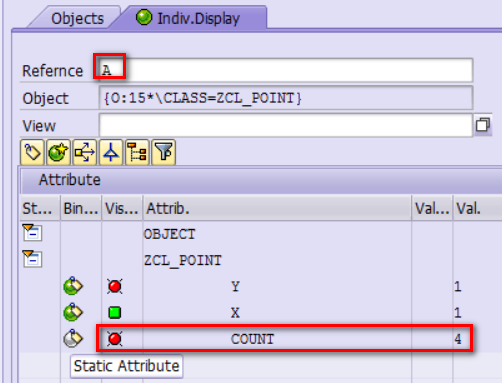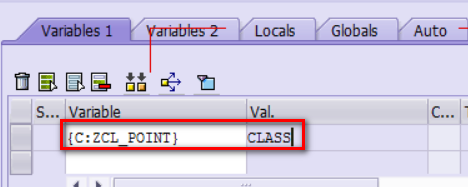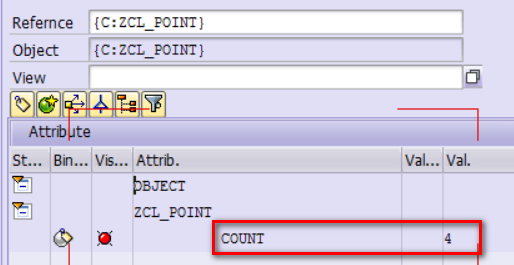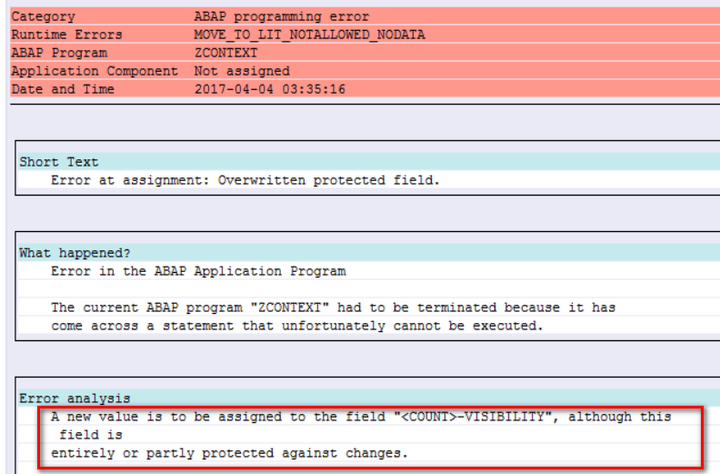In ABAP we can define a static attribute for a class via keyword CLASS-DATA, whose validity is not associated with instances of a class but with the class itself. In order to prove this fact I use the following simple Pointer class for demonstration:
class ZCL_POINT definition
public
final
create public .public section.
data X type I .
methods CONSTRUCTOR
importing
!IV_X type I
!IV_Y type I .private section.
data Y type I .
class-data COUNT type I .ENDCLASS.CLASS ZCL_POINT IMPLEMENTATION.
method CONSTRUCTOR.
me->x = iv_x.
me->y = iv_y.
count = count + 1.
endmethod.ENDCLASS.In this class, static attribute count is responsible to maintain the number of created Point instances. Then create four point instances:
data(a) = new zcl_point( iv_x = 1 iv_y = 1 ).data(b) = new zcl_point( iv_x = 1 iv_y = 2 ).data(c) = new zcl_point( iv_x = 1 iv_y = 3 ).data(d) = new zcl_point( iv_x = 1 iv_y = 4 ).Via any variable of a, b, c or d, we can monitor the value of count in debugger.

Can we access the static attribute of a class without object instance in debugger?
Since in theory the static attribute belongs to class instead of any dedicated object instance, so question comes: is there approach to monitor the static attribute value in ABAP debugger directly from class instead? Yes it is possible.
(1) type text “{C:ZCL_POINT} in debugger and press enter key

(2) double click, and you can see the attribute value is directly maintained in class ZCL_POINT, without any object instance created on top of it.

And I try to change its visibility dynamically via class descriptor via the following code and actually it is not possible:
data(lo) = CAST cl_abap_objectdescr( cl_abap_classdescr=>describe_by_name( 'ZCL_POINT' ) ).read TABLE lo->attributes ASSIGNING FIELD-SYMBOL() WITH KEY name = 'COUNT'.CHECK SY-SUBRC = 0.-visibility = 'U'. Since the structure is read-only and not editable outside cl_abap_objectdescr.


This makes sense otherwise the encapsulation will be violated. Just check many other attribute marked as read-only in Class/Object descriptor class.

Reflection in Java
Check the following code which demonstrates how to access private static attribute value in code via Reflection.
import java.lang.reflect.Field;public class Point {
private int x;
private int y;
static private int count = 0;
public Point(int x, int y){
this.x = x;
this.y = y;
count++;
}
private static void accessStaticPrivate(Point point){
Class classObject = point.getClass();
try {
Field countField = classObject.getDeclaredField("count");
System.out.println("count: " + countField.get(point));
} catch (NoSuchFieldException | SecurityException | IllegalArgumentException
| IllegalAccessException e1 ) {
e1.printStackTrace();
}
}
public static void main(String[] arg){
Point a = new Point(1,2);
accessStaticPrivate(a);
Point b = new Point(1,3);
accessStaticPrivate(b);
Point c = new Point(1,4);
accessStaticPrivate(c);
Point d = new Point(1,5);
accessStaticPrivate(d);
}}For ABAPer it is easy to understand the usage of Class object in Java by just comparing it with CL_ABAP_CLASSDESCR in ABAP. When running this small program locally, you will get output in console:
count: 1count: 2count: 3count: 4Unlike RTTI in ABAP, Java reflection can sometimes lead to security issues, see one example how Java Singleton would be bypassed in blog Singleton bypass – ABAP and Java.
要获取更多Jerry的原创文章,请关注公众号"汪子熙":
